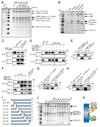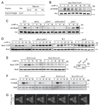A Ras signaling complex controls the RasC-TORC2 pathway and directed cell migration
- PMID: 20493808
- PMCID: PMC2893887
- DOI: 10.1016/j.devcel.2010.03.017
A Ras signaling complex controls the RasC-TORC2 pathway and directed cell migration
Abstract
Ras was found to regulate Dictyostelium chemotaxis, but the mechanisms that spatially and temporally control Ras activity during chemotaxis remain largely unknown. We report the discovery of a Ras signaling complex that includes the Ras guanine exchange factor (RasGEF) Aimless, RasGEFH, protein phosphatase 2A (PP2A), and a scaffold designated Sca1. The Sca1/RasGEF/PP2A complex is recruited to the plasma membrane in a chemoattractant- and F-actin-dependent manner and is enriched at the leading edge of chemotaxing cells where it regulates F-actin dynamics and signal relay by controlling the activation of RasC and the downstream target of rapamycin complex 2 (TORC2)-Akt/protein kinase B (PKB) pathway. In addition, PKB and PKB-related PKBR1 phosphorylate Sca1 and regulate the membrane localization of the Sca1/RasGEF/PP2A complex, and thereby RasC activity, in a negative feedback fashion. Thus, our study uncovered a molecular mechanism whereby RasC activity and the spatiotemporal activation of TORC2 are tightly controlled at the leading edge of chemotaxing cells.
Copyright 2010 Elsevier Inc. All rights reserved.
Figures







References
-
- Affolter M, Weijer CJ. Signaling to cytoskeletal dynamics during chemotaxis. Dev. Cell. 2005;9:19–34. - PubMed
-
- Alessi DR, Caudwell FB, Andjelkovic M, Hemmings BA, Cohen P. Molecular basis for the substrate specificity of protein kinase B; comparison with MAPKAP kinase-1 and p70 S6 kinase. FEBS Lett. 1996;399:333–338. - PubMed
-
- Andrew N, Insall RH. Chemotaxis in shallow gradients is mediated independently of PtdIns 3-kinase by biased choices between random protrusions. Nat. Cell Biol. 2007;9:193–200. - PubMed
-
- Annesley SJ, Fisher PR. Dictyostelium discoideum-a model for many reasons. Mol. Cell. Biochem. 2009;329:73–91. - PubMed
-
- Axelrod D. Total internal reflection fluorescence microscopy in cell biology. Traffic. 2001;2:764–774. - PubMed
Publication types
MeSH terms
Substances
Grants and funding
LinkOut - more resources
Full Text Sources
Other Literature Sources
Molecular Biology Databases
Miscellaneous

